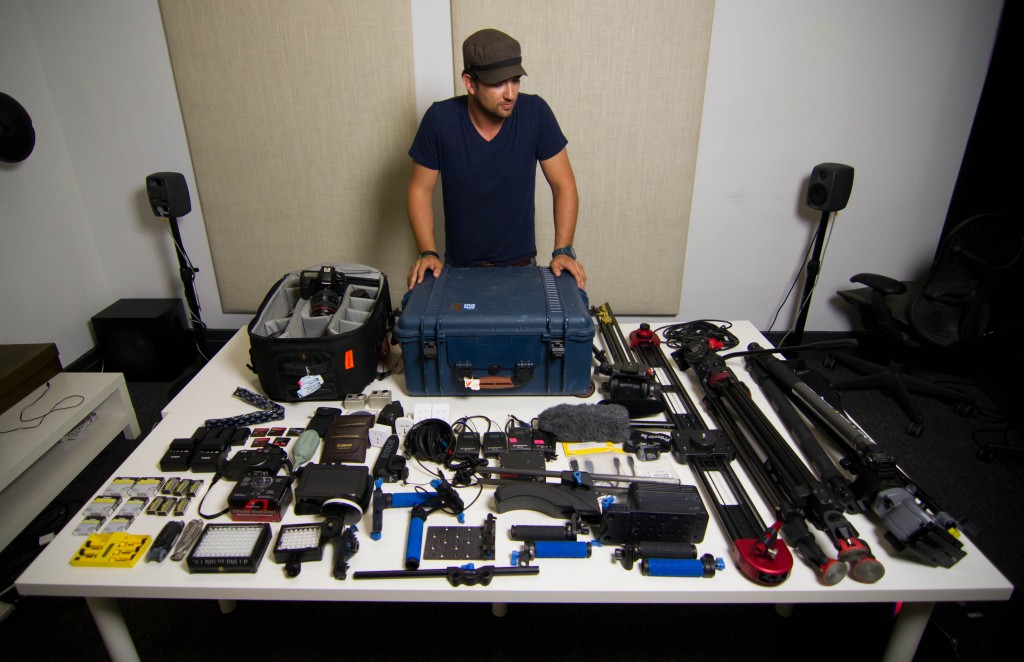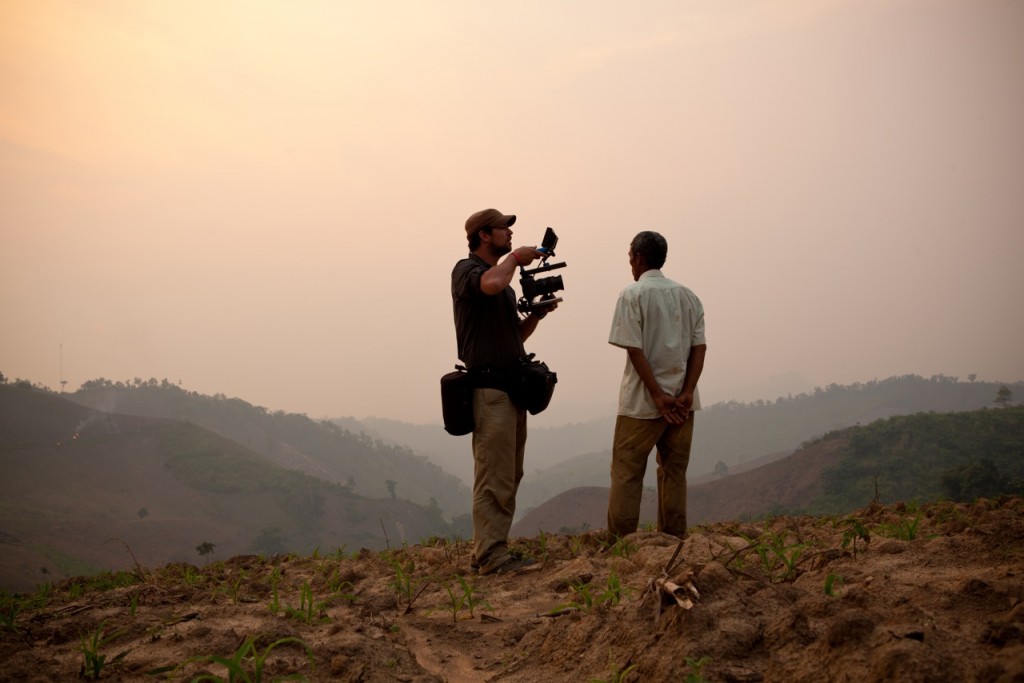Rick Gershon joined MediaStorm as a producer in 2010. He served as a multimedia photojournalist and staff photographer at Getty Images from 2007 to 2010.
Some of his clients include the Discovery Channel, History Channel, A&E, The Travel Channel, AOL.com and MSNBC. His images of various news and political events have run in newspapers and news magazines around the world and he is a featured photographer with Reportage by Getty Images.

Can you give us a general overview of your kit and the gear you’re using?
As you can see I have a ton of gear. You certainly don’t have to have all this gear to do it, but I use every single piece of it. A lot of this gear is honestly used to make the Canon 5D Mark II function like a professional video camera. It’s a still camera. It’s not built to be a video camera. To shoot rock solid video and be able to hand hold it without it looking like Blair Witch Project you need certain things. This is a kit that I built up over years and years of failing. Each one of these pieces was bought after I wasn’t able to do something that I wanted to do. Shooting, failing, and fixing it. That’s really what it’s about. Going out and shooting, not getting the results I want, deciding why I didn’t get those results, and then trying to fix that.
A lot of this also comes from going somewhere international and not having an adapter or not being able to find one, or working in Mexico and breaking my monitor cable for my monitor and going to ten different electronic shops to find one. Now I travel with 4. And at the time I travelled with 3, and I broke 2 of them. It’s a matter of experience and getting everything to where I’m comfortable. I know I have everything. I probably travel with more than I need. I prefer to have 2 to 3 of everything so that I’m prepared.
How would you describe your shooting style?
I have a run-and-gun style but it depends on the shoot. If I’m doing a pure documentary shoot I try to get my camera rig as small and low-profile as possible. If it’s more of an advertising shoot, then I’ll use a more built out rig. A big part of run-and-gun documentary work is having a kit that is easy to carry and easy to work with. I know from this table it doesn’t look like this is that, but it actually is. Everything on here is tailored to a smaller set up.
Let’s get specific on gear, what do you use?
I have two carbon fiber tripods (Miller DV20, Sachtler FSB-8T), both of them do very different things, both are super useful. The reason I carry two tripods is for two camera interviews and the slider takes two tripods. My rig allows me to keep my camera steady while also keeping it low profile. I have two basic Redrock setups, one is a shoulder rig that’s a little bigger with weights and everything, and the other is smaller hand-held rig. I have a monitor which is key. If I’m doing a bigger shoot, like an ad shoot where it’s easier to work and I have more time, then I’ll bring a full light kit. On international gigs I usually don’t bring a full light kit, I try to just use available light.
Really to me this is about multiples of everything: I have 6 adapters, 6 batteries, 2 chargers, 5 cards, 2 circular ND filters, a 6 stop filter, and a few UV filters, 5 XLR cables, 2 Shotgun mics, 2 Sennheiser Wireless Kits, I have a couple of different small hot shoe mountable shotgun mics, 3 or 4 HDMI cables for my monitor, multiple tripod mount plates because they disappear, I always bring a couple leathermans, I bring two or three headlamps which is totally insane and OCD, but I do it anyway. I have to travel with two mic holding shock mounts because they break easily. I travel with tons of batteries because international batteries suck. One time I was stuck in China and I ran out of batteries and I got some cheap batteries from a market and literally, they would go out in 30 minutes. Velcro, gaff tape – always bring gaff tape. All that on top of my camera kit: I have two camera bodies, 5 lenses and an extender, and I usually travel with another still body like my Leica.
How do you pack all of that?
When I’m packing I bring a smaller carry-on that has my essential gear, so that’s my camera and my lenses, my cards, and some batteries. So if the rest of my gear was stolen or lost, I could still get the job done, I could still work. That’s leftover from my old journalist days, you always have your camera with you on the plane. It’s kind of getting hard with all this gear. I really do need a lot of the stuff that I check but I could still get the job done. I also carry a 17″ MacBook Pro, 2 2TB G-Drives. I carry at least 5 or 6 firewire 800, 400, and 400 to 800 cords, 3 CF card readers, 2 SD card readers. That goes in the carry-on as well.

How are you managing data in the field?
I keep my cards on me and at the end of the day I go home and download it and then I back it up. So I usually do 2 hard drives, sometimes 3, it just depends on the situation. 2 Drives: download to the first one, backup to the second one. I download often and backup immediately.
Work-flow wise, when you’ve got all that data and you come back state-side, what are you doing with it?
The first thing I do no matter how jet lagged I am is bring in the drives and have them downloaded to more stable and secure drives. And then back those up again, so that they’re in 4 places. So even if I get in at 6:00 in the morning after flying for two days I’ll come straight here and drop off my hard drives because I never want anything to happen to them. On some gigs clients will want me to ship a hard drive back to them. So then I have three drives at all times and download to one, backup to the others, and then ship one back. Whenever I travel I put the hard drives in different peoples bags just so they’re never in the same place in case a bag gets stolen, lost, or water gets in it.
We talked about electricity and batteries, when you’re planning on powering all of this gear for a shoot what’s going through your mind in terms of power requirements in the field and electricity differences?
It’s really batteries, that’s why I carry six batteries. I don’t usually go through that many in a day. Honestly I should probably get more. I’d be more comfortable if I had two or three more. I have just enough to get through a 10 hour day right now. I always carry my chargers if I ever have a chance to stop with a place that has electricity I plug them in. You just never know when you’re going to have the chance to charge. Always, always, always keep your batteries charged. That’s the key.
Let’s talk about this with audio. It seems like audio can really bring down a visually gorgeous piece. How do you make sure the audio isn’t lacking?
It’s certainly a huge challenge for these cameras. I personally do not like to record sound separately. There’s a couple reasons. It takes a lot of time to sync up in post and it’s also just another piece of gear that I have to think about turning on and off. And honestly, the less on and off record buttons I have to press the better.
I like to use the juicedLink, I’ve tried a lot of different audio adapters and that one is the best. It’s super low noise. It takes a little bit to get dialed in correctly though. You don’t want to buy it out of the box and go shoot with it, you want to practice. I’ve failed with it a lot, you’ve got to fail with your gear. You’ve got to know it really well, you have to be able to put this stuff together in the dark.
I also really like the new Rode VideoMic Pro. It’s an awesome broadcast quality small shotgun mic. I really love using that for ambient stuff when I’m not doing an interview or I don’t have essential narrative audio going on. I’m a photographer first so audio is definitely second to me, but learning how to get good audio, especially with these 5D cameras, really puts you ahead of the game. The 5D is not a real hard camera to get a beautiful image out of. A lot of people can take it out get something beautiful out of it. But to really operate it like a pro camera and get great audio takes some practice.
How can people step up their game?
I can tell you there are a few things that separate an amateur kit from a pro kit. Things that will really up your game.
1) A really good tripod and head (Miller DV20, Sachtler FSB-8T). People buy cheap amateur tripods and their video is shaky, and it doesn’t look good. All they can do is the set off locked shots. Shots that are too shaky and aren’t on the tripod can look super amateur but also stuff that’s too locked down can look amateur too. To step up your game one thing that can really help is a really good tripod and fluid pan/tilt head, a good video head.
2) Working with ND Filters. That’s a big step when it comes to using this 5D. These cameras do not look good in broad daylight. They don’t look good stopped down. I use a variable ND filter that allows me to have that flexibility and being able to shoot shallow in bring sun really ups your game on a video level.
3) Working off a monitor. The screens on the backs of those cameras suck. It’s really hard to focus off of and it doesn’t give you a lot of freedom for putting the camera in different positions. I bought a nice external monitor and it’s really changed my game. It’s allowed me to get the camera in different positions its allowed me to get critical focus every single time and that’s huge.
4) Having a good stabilization rig. Handholding that camera without a rig, you know you transfer all of your body movements and shake into that camera, and it shows big time. Having a good stabilization rig that you’re comfortable with but that also allows you to shoot well will up your game. People can err on the other side, having too big of a rig, having too much cumbersome equipment that doesn’t allow them to be fluid and doesn’t allow them to work well.
What it boils down to though is that story is king. All this equipment is for the point of allowing me to tell a story in the best way possible. And if I ever have gear that gets in the way of that, then I need to get rid of it. If I ever have gear that keeps me from getting to the heart of my story and connecting with my subjects, than it’s not worth it. I’ll sell it.
What people need to learn is that they need to build up the kit that works for them, that’s the most comfortable for them in the field. If you’re not comfortable shooting with something in the field, you’re not going to make great images and you’re not going to tell a great story.
Closing Thoughts?
My advice is to find out what works best for you. Ask a lot of people. Definitely don’t look at what I have and go buy it. Ask 4 or 5 other people who are doing work you admire and find out what they all use. Tailor your kit to your needs and then practice, practice, practice.

